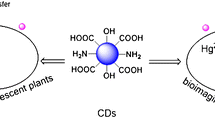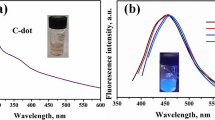Abstract
A simple and efficient fluorometric method is described for detecting mercury (II) ions. Carbon quantum dots doped with nitrogen, sulfur, phosphorus, and boron were prepared by a one-step hydrothermal method for first time that involves heating of a solution of glucose, thiourea, boric acid, and phosphoric acid in an autoclave simultaneously for 5 h at 200° C. The carbon quantum dots with phosphorus, sulfur, boron, and nitrogen atom (PNBS-CQDs) are a viable probe for fluorometric detection of Hg2+. Unlike CQD-based probes reported so far, the addition of Hg2+ causes a decrease in fluorescence signal (with excitation/emission maxima at 450/530 nm). The probe has a linear response in the 25.0 μM to 1500.0 mM of Hg2+ concentration range with 5.0 µM (S/N = 3) and 16.5 µM for LOD and LOQ, respectively. The developed method was successfully applied for determining the mercury (II) ions in real samples.








Similar content being viewed by others
References
M.N. Khan, M.F. Wahab, Characterization of chemically modified corncobs and its application in the removal of metal ions from aqueous solution. J. Hazard. Mater. 141(1), 237–244 (2007)
A. Renzoni, F. Zino, E. Franchi, Mercury levels along the food chain and risk for exposed populations. Environ. Res. 77(2), 68–72 (1998)
E.M. Nolan, S.J. Lippard, Tools and tactics for the optical detection of mercuric ion. Chem. Rev. 108(9), 3443–3480 (2008)
J. Gutknecht, Inorganic mercury (Hg2+) transport through lipid bilayer membranes. J. Membr. Biol. 61(1), 61–66 (1981)
P.B. Tchounwou, W.K. Ayensu, N. Ninashvili, D. Sutton, Environmental exposure to mercury and its toxicopathologic implications for public health. Environ. Toxicol. 18(3), 149–175 (2003)
S. Zinatloo-Ajabshir, N. Ghasemian, M. Salavati-Niasari, Green synthesis of Ln2Zr2O7 (Ln= Nd, Pr) ceramic nanostructures using extract of green tea via a facile route and their efficient application on propane-selective catalytic reduction of NOx process. Ceram. Int. 46(1), 66–73 (2020)
S. Zinatloo-Ajabshir, Z. Salehi, O. Amiri, M. Salavati-Niasari, Simple fabrication of Pr2Ce2O7 nanostructures via a new and eco-friendly route; a potential electrochemical hydrogen storage material. J. Alloys Compd. 791, 792–799 (2019)
S. Zinatloo-Ajabshir, M. Salavati-Niasari, Preparation of magnetically retrievable CoFe2O4@ SiO2@ Dy2Ce2O7 nanocomposites as novel photocatalyst for highly efficient degradation of organic contaminants. Compos. B 174, 106930 (2019)
S. Zinatloo-Ajabshir, M.S. Morassaei, M. Salavati-Niasari, Facile synthesis of Nd2Sn2O7-SnO2 nanostructures by novel and environment-friendly approach for the photodegradation and removal of organic pollutants in water. J. Environ. Manage. 233, 107–119 (2019)
S. Zinatloo-Ajabshir, M.S. Morassaei, M. Salavati-Niasari, Eco-friendly synthesis of Nd2Sn2O7–based nanostructure materials using grape juice as green fuel as photocatalyst for the degradation of erythrosine. Compos. B 167, 643–653 (2019)
S. Zinatloo-Ajabshir, M. Salavati-Niasari, A. Sobhani, Z. Zinatloo-Ajabshir, Rare earth zirconate nanostructures: recent development on preparation and photocatalytic applications. J. Alloys Compd. 767, 1164–1185 (2018)
F. Razi, S. Zinatloo-Ajabshir, M. Salavati-Niasari, Preparation, characterization and photocatalytic properties of Ag2ZnI4/AgI nanocomposites via a new simple hydrothermal approach. J. Mol. Liq. 225, 645–651 (2017)
G. Tz, J. Baasner, M. Gradl, A. Kistner, Determination of mercury in saliva with a flow-injection system. Anal. Chim. Acta 320(2–3), 171–176 (1996)
H.-T. Wang, B. Kang, T. Chancellor Jr., T. Lele, Y. Tseng, F. Ren, S. Pearton, W. Johnson, P. Rajagopal, J. Roberts, Fast electrical detection of Hg (II) ions with Al Ga N∕ Ga N high electron mobility transistors. Appl. Phys. Lett. 91(4), 042114 (2007)
H. Li, J. Zhai, J. Tian, Y. Luo, X. Sun, Carbon nanoparticle for highly sensitive and selective fluorescent detection of mercury (II) ion in aqueous solution. Biosens. Bioelectron. 26(12), 4656–4660 (2011)
S. Choi, R.M. Dickson, J. Yu, Developing luminescent silver nanodots for biological applications. Chem. Soc. Rev. 41(5), 1867–1891 (2012)
X. Michalet, F. Pinaud, L. Bentolila, J. Tsay, S. Doose, J. Li, G. Sundaresan, A. Wu, S. Gambhir, S. Weiss, Quantum dots for live cells, in vivo imaging, and diagnostics. Science 307(5709), 538–544 (2005)
L. Shang, S. Dong, G.U. Nienhaus, Ultra-small fluorescent metal nanoclusters: synthesis and biological applications. Nano Today 6(4), 401–418 (2011)
R. Hardman, A toxicologic review of quantum dots: toxicity depends on physicochemical and environmental factors. Environ. Health Perspect. 114(2), 165–172 (2005)
A.M. Derfus, W.C. Chan, S.N. Bhatia, Probing the cytotoxicity of semiconductor quantum dots. Nano Lett. 4(1), 11–18 (2004)
S. Tedesco, H. Doyle, J. Blasco, G. Redmond, D. Sheehan, Oxidative stress and toxicity of gold nanoparticles in Mytilus edulis. Aquat. Toxicol. 100(2), 178–186 (2010)
P. Jing, D. Han, D. Li, D. Zhou, D. Shen, G. Xiao, B. Zou, S. Qu, Surface related intrinsic luminescence from carbon nanodots: solvent dependent piezochromism. Nanoscale Horizons 4(1), 175–181 (2019)
A. Barati, M. Shamsipur, H. Abdollahi, Hemoglobin detection using carbon dots as a fluorescence probe. Biosens. Bioelectron. 71, 470–475 (2015)
T.T. Bui, S.-Y. Park, A carbon dot–hemoglobin complex-based biosensor for cholesterol detection. Green Chem. 18(15), 4245–4253 (2016)
S. Dolai, S.K. Bhunia, R. Jelinek, Carbon-dot-aerogel sensor for aromatic volatile organic compounds. Sens. Actuators B 241, 607–613 (2017)
C. Ding, A. Zhu, Y. Tian, Functional surface engineering of C-dots for fluorescent biosensing and in vivo bioimaging. Acc. Chem. Res. 47(1), 20–30 (2013)
S.K. Bhunia, S. Dolai, H. Sun, R. Jelinek, “On/off/on” hydrogen-peroxide sensor with hemoglobin-functionalized carbon dots. Sens. Actuators B 270, 223–230 (2018)
L.S. Walekar, P. Hu, F. Liao, X. Guo, M. Long, Turn-on fluorometric and colorimetric probe for hydrogen peroxide based on the in-situ formation of silver ions from a composite made from N-doped carbon quantum dots and silver nanoparticles. Microchim. Acta 185(1), 31 (2018)
W. Lu, X. Qin, S. Liu, G. Chang, Y. Zhang, Y. Luo, A.M. Asiri, A.O. Al-Youbi, X. Sun, Economical, green synthesis of fluorescent carbon nanoparticles and their use as probes for sensitive and selective detection of mercury (II) ions. Anal. Chem. 84(12), 5351–5357 (2012)
Y. Tang, L. Rao, Z. Li, H. Lu, C. Yan, S. Yu, X. Ding, B. Yu, Rapid synthesis of highly photoluminescent nitrogen-doped carbon quantum dots via a microreactor with foamy copper for the detection of Hg 2+ ions. Sens. Actuators B 258, 637–647 (2018)
D. Sun, R. Ban, P.-H. Zhang, G.-H. Wu, J.-R. Zhang, J.-J. Zhu, Hair fiber as a precursor for synthesizing of sulfur-and nitrogen-co-doped carbon dots with tunable luminescence properties. Carbon 64, 424–434 (2013)
C. Zhao, Y. Jiao, L. Zhang, Y. Yang, One-step synthesis of S, B co-doped carbon dots and their application for selective and sensitive fluorescence detection of diethylstilbestrol. New J. Chem. 42(4), 2857–2864 (2018)
X. Gong, Q. Zhang, Y. Gao, S. Shuang, M.M. Choi, C. Dong, Phosphorus and nitrogen dual-doped hollow carbon dot as a nanocarrier for doxorubicin delivery and biological imaging. ACS Appl. Mater. Interfaces 8(18), 11288–11297 (2016)
X. Gong, Q. Hu, M.C. Paau, Y. Zhang, S. Shuang, C. Dong, M.M. Choi, Red-green-blue fluorescent hollow carbon nanoparticles isolated from chromatographic fractions for cellular imaging. Nanoscale 6(14), 8162–8170 (2014)
X. Jin, X. Sun, G. Chen, L. Ding, Y. Li, Z. Liu, Z. Wang, W. Pan, C. Hu, J. Wang, pH-sensitive carbon dots for the visualization of regulation of intracellular pH inside living pathogenic fungal cells. Carbon 81, 388–395 (2015)
R. Qian, L. Ding, L. Bao, S. He, H. Ju, In situ electrochemical assay of cell surface sialic acids featuring highly efficient chemoselective recognition and a dual-functionalized nanohorn probe. Chem. Commun. 48(32), 3848–3850 (2012)
X. Gong, Y. Liu, Z. Yang, S. Shuang, Z. Zhang, C. Dong, An “on-off-on” fluorescent nanoprobe for recognition of chromium (VI) and ascorbic acid based on phosphorus/nitrogen dual-doped carbon quantum dot. Anal. Chim. Acta 968, 85–96 (2017)
X. Gong, W. Lu, M.C. Paau, Q. Hu, X. Wu, S. Shuang, C. Dong, M.M. Choi, Facile synthesis of nitrogen-doped carbon dots for Fe3+ sensing and cellular imaging. Anal. Chim. Acta 861, 74–84 (2015)
L. Ji, L. Chen, P. Wu, D.F. Gervasio, C. Cai, Highly selective fluorescence determination of the hematin level in human erythrocytes with no need for separation from bulk hemoglobin. Anal. Chem. 88(7), 3935–3944 (2016)
V.K. Singh, P.K. Yadav, S. Chandra, D. Bano, M. Talat, S.H. Hasan, Peroxidase mimetic activity of fluorescent NS-carbon quantum dots and their application in colorimetric detection of H 2 O 2 and glutathione in human blood serum. Journal of Materials Chemistry B 6(32), 5256–5268 (2018)
A. Barati, M. Shamsipur, H. Abdollahi, Carbon dots with strong excitation-dependent fluorescence changes towards pH. Application as nanosensors for a broad range of pH. Anal. Chim. Acta 931, 25–33 (2016)
R.R. Raposo, E. Meléndez-Hevia, M. Spiro, Autocatalytic formation of colloidal mercury in the redox reaction between Hg2+ and Fe2+ and between Hg22+ and Fe2+. J. Mol. Catal. A 164(1–2), 49–59 (2000)
Y. Guo, Z. Wang, H. Shao, X. Jiang, Hydrothermal synthesis of highly fluorescent carbon nanoparticles from sodium citrate and their use for the detection of mercury ions. Carbon 52, 583–589 (2013)
C. Wang, D. Sun, K. Zhuo, H. Zhang, J. Wang, Simple and green synthesis of nitrogen-, sulfur-, and phosphorus-co-doped carbon dots with tunable luminescence properties and sensing application. RSC Adv. 4(96), 54060–54065 (2014)
S. He, D. Li, C. Zhu, S. Song, L. Wang, Y. Long, C. Fan, Design of a gold nanoprobe for rapid and portable mercury detection with the naked eye. Chem. Commun. 40, 4885–4887 (2008)
F. Coppin, J. Michon, C. Garnier, S. Frelon, Fluorescence quenching determination of uranium (VI) binding properties by two functional proteins: Acetylcholinesterase (AChE) and vitellogenin (Vtg). J. Fluorescence 25(3), 569–576 (2015)
Y. Liu, H. Xue, J. Liu, Q. Wang, L. Wang, Carbon quantum dot-based fluorometric nitrite assay by exploiting the oxidation of iron (II) to iron (III). Microchim. Acta 185(2), 129 (2018)
Acknowledgements
The authors gratefully acknowledge the Research Council of Kermanshah University of Medical Sciences (Grant Number: 980547) for financial support.
Author information
Authors and Affiliations
Corresponding authors
Ethics declarations
Conflict of interest
The authors declare that they have no conflict of interest.
Additional information
Publisher's Note
Springer Nature remains neutral with regard to jurisdictional claims in published maps and institutional affiliations.
Rights and permissions
About this article
Cite this article
Karami, C., Taher, M.A. & Shahlaei, M. A simple method for determination of mercury (II) ions by PNBS-doped carbon dots as a fluorescent probe. J Mater Sci: Mater Electron 31, 5975–5983 (2020). https://doi.org/10.1007/s10854-020-03157-5
Received:
Accepted:
Published:
Issue Date:
DOI: https://doi.org/10.1007/s10854-020-03157-5




